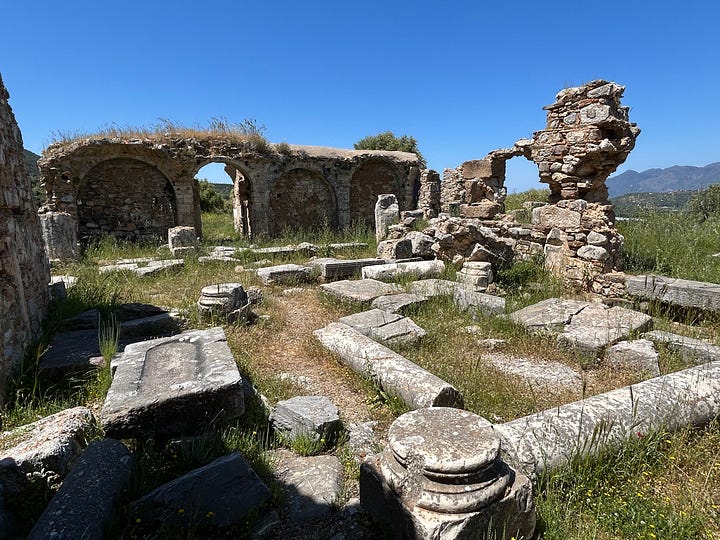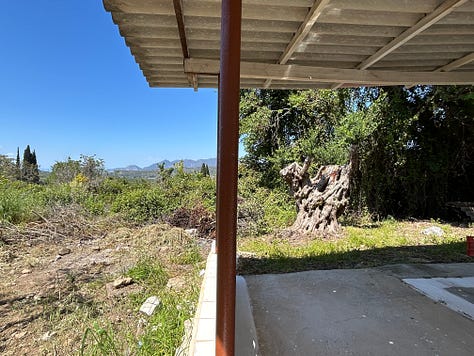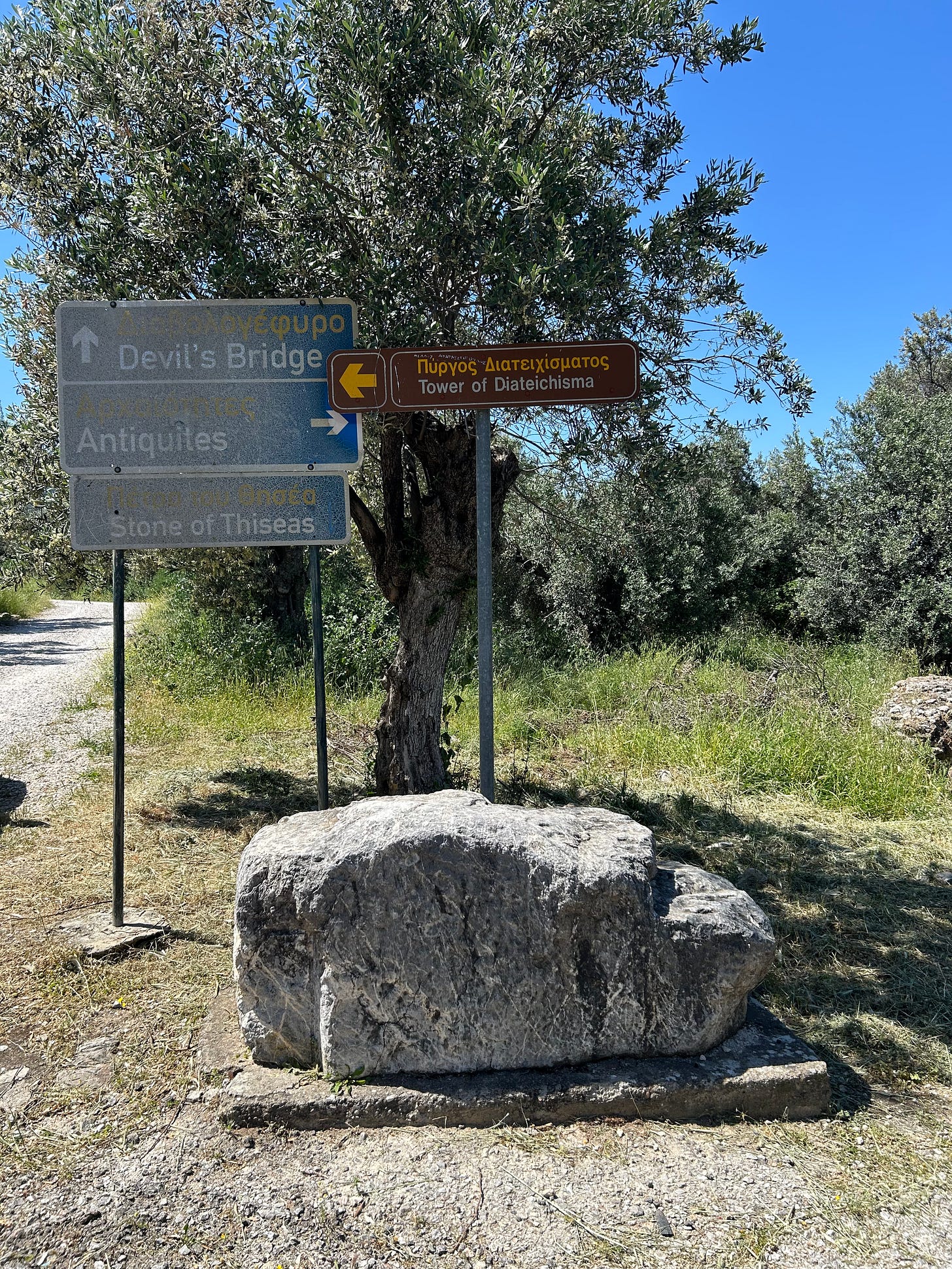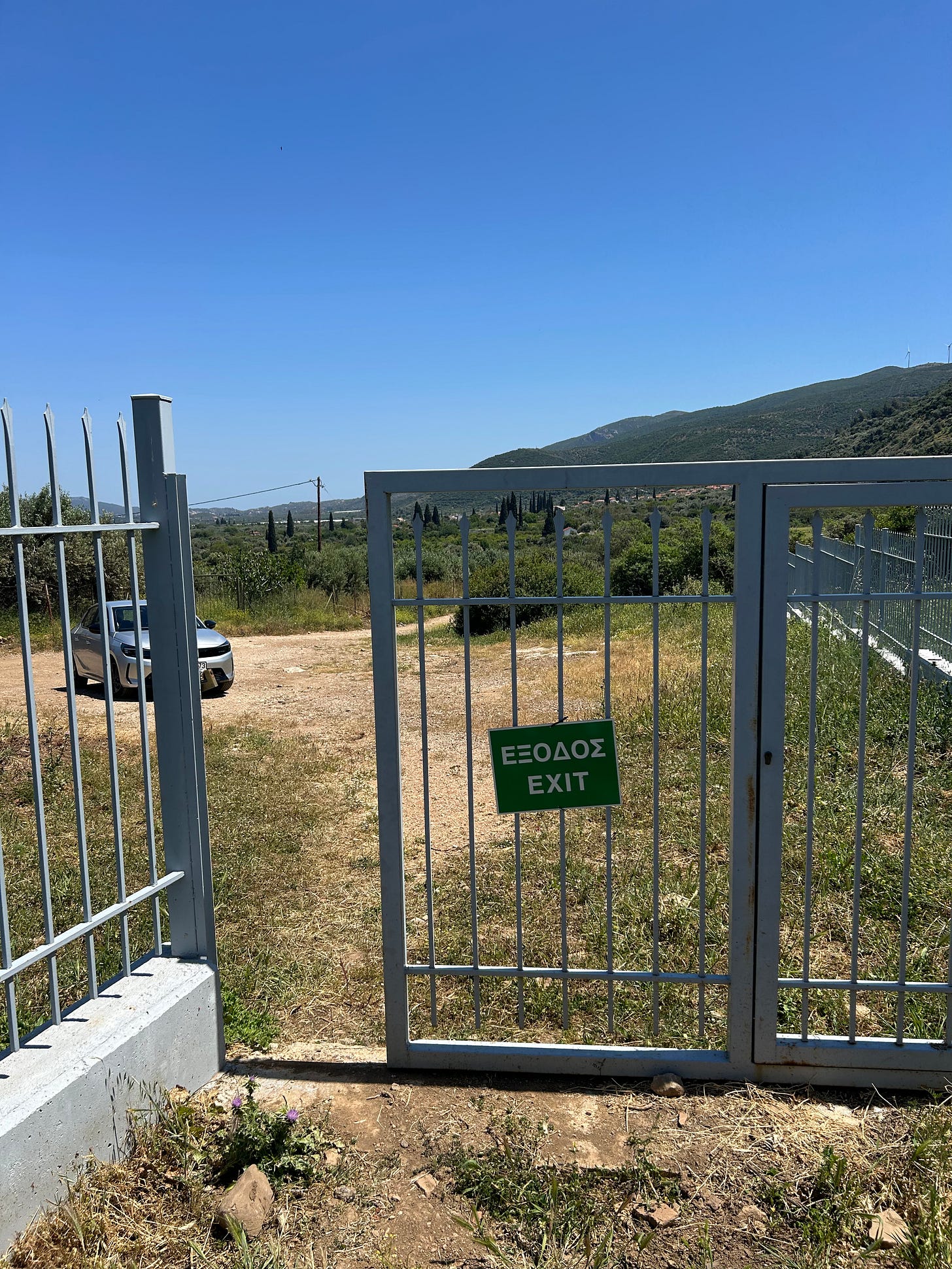Day One. The first full day of the Artemis Mapping Expedition, and already the roads were winding, the maps were lying, and the goddess was hiding.
Our destination? The ancient city of Troizen (also spelled Troezen), tucked into the northeastern Peloponnese. This was a site of particular interest for us, not only because of its deep mythological associations with figures like Theseus and Hippolytus, but because several ancient sources, including Pausanias, indicate the presence of a Temple of Artemis somewhere in or near the city, and we hoped she might be linked to the Sanctuary of Hippolytus.
We started the day by catching the ferry from Galatas to Poros. I had a faint hope that the Poros Archaeological Museum might offer a map or even a sliver of insight into where exactly the temples we were chasing might be. Instead, we got two rooms of vaguely labeled artifacts and an air of quiet resignation. Still, it gave me a moment to buy a red straw hat (a necessary move in the Greek spring sun), and to try the most divine feta pastry I’ve ever tasted while waiting for Sandra.
Then the chaos began.
Back on the mainland, the modern village of Troizen had us twisting in and out of roads that didn’t seem to exist on Google or Apple Maps. We got stuck, lost, and redirected more times than I could count.
Eventually, we stopped near a quiet courtyard where an older woman and her teenage grandson sat watching us with polite curiosity. Sandra explained in her expanding skilled Greek that we were looking for ancient ruins, something sacred. The boy, with a sort of casual confidence, offered to lead us out of the chaos on his scooter.
He zipped ahead, guiding us through a maze of turns until he paused beside a low field and a weathered rock, the so-called Stone of Theseus. According to myth, Aegeus left his sword and sandals beneath this stone for his son to find when he came of age. When Theseus came of age, he lifted the stone and claimed his identity. Standing there, however, it was hard to feel the myth. The stone felt more symbolic than stirring… a marker of a hero whose legacy, frankly, has not aged well. Theseus, while lauded in Athenian lore, has always struck me as a problematic figure. Still, it was good to see the physical echo of a story so often repeated.
Our real goal was the Sanctuary of Hippolytus. After finding a worn sign on a dirt road, we drove until the road became more weeds than path, and we reached a fenced site with a gate labeled "Exit." Naturally, we entered.
Inside, spring had taken over. Wild grasses towered around us, fennel and vines crisscrossed our path. I wore sandals (not ideal), while Sandra, always wiser in footwear, braved the brush in runners. And there, hidden beneath all that green, were the base stones of the ancient sanctuary. That is all that remains of the Temple of Hippolytus, just the foundation. No columns, no marble. But stone is still stone, and presence is still presence.
According to Pausanias (Description of Greece, 2.32.1), Hippolytus, the ill-fated son of Theseus, was a devout follower of Artemis. The people of Troizen held him in reverence, establishing sacred rites and dedicating a lock of maiden’s hair to him before marriage:
"In Troizen is a sanctuary of Hippolytus... every year they perform sacred rites in honor of Hippolytus, and maidens before marriage dedicate a lock of their hair to him."
A short distance away sits a small church to Panagia, the Virgin Mary, built directly over the remains of what was once a Temple of Aphrodite. The church incorporates stones and columns from the ancient sanctuary. Another layer. Another erasure.


Two more unmarked structures stand nearby, one west-facing, rectangular, and possibly once sacred. While there's no signage to confirm it, we suspect one may have been dedicated to Artemis, given the close connection between her and Hippolytus. As Euripides tells us:
"I honour you, Artemis, with no mortal's love, but with a love divine. I keep myself pure for you, hunting in the woods, as you delight." (Hippolytus, 73-75)
After documenting what we could, we were still a bit disoriented. We knew there was supposed to be a monastery nearby, the Monastery of St. George (Agiou Georgiou) but we hadn't been able to find it.
On the way down with our scooter guide, we had actually passed a small sign for the Monastery of St. George (Monē tou Agiou Georgiou), but in the chaos of navigating unfamiliar roads and trying to keep up with a teenager on two wheels, we hadn’t paid it much attention. Later, after realizing we were once again map-confused and site-thwarted, Sandra paused and said, “You know what? Let’s just park back at the stone and go back up the way we came down. Let’s look around.”
So we did. We left the car near the Stone of Theseus and retraced our steps on foot. Sandra walked a bit ahead and spotted it, the modest sign we had missed before.



The monastery sits on a ridge, with commanding views, and though modern in form, its placement aligns with patterns of sacred continuity.
But the land around it was wild. Overgrown. Impenetrable. We followed a narrow canal, peered through trees, and circled thorn-covered paths. We didn’t find Artemis that day. Not in stone. Not in ruins. Not in any visible trace.
And yet, we know she’s there. Based on topographical data, archaeological reports, and classical sources, this may have once been the location of the Temple of Artemis Soteira. The coordinates align. The history holds.
Historical and Archaeological Context
The archaeological site around the Monastery of St. George has long been suspected to correspond with an ancient sanctuary. According to Maria Giannopoulou's 2009 study, recent excavations in ancient Troizen uncovered the eastern part of a temple, preserved up to its poros foundation, in the northwest sector of the ancient city, precisely the area where the Church of St. George now stands. Giannopoulou's findings align with G. Welter’s historical maps, which associate this area with the sanctuary of Zeus Soter, though the layering of sacred spaces complicates precise attribution (Giannopoulou, 2009).
The Chronique des fouilles en ligne further supports the significance of this area, emphasizing the need for continued topographical and stratigraphic study to clarify sanctuary placement in Troizen's urban layout (Chronique, 2003).
Classical sources also provide essential insight. Pausanias (Description of Greece, 2.31–2.32) identifies several sanctuaries of Artemis in Troizen, each linked to different aspects of her cult and to local myth:
Artemis Soteira (Saviour): Located in the agora (marketplace), this sanctuary was founded by Theseus after his return from Crete.
Artemis Lykeia (Wolfish): Situated near the theater, attributed to Hippolytus.
Artemis Saronia: Associated with the myth of King Saron, reflecting her maritime and liminal dimensions.
These variant cults illustrate the prominence of Artemis in Troizen’s religious landscape, each reflecting local identity, mythological legacy, and civic memory. Given the historical layering of sacred spaces and the documented reuse of earlier materials in Byzantine ecclesiastical architecture, it is plausible that the Church of St. George may in fact overlay or sit adjacent to the ancient Temple of Artemis Soteira.
The Three Sanctuaries of Artemis in Troizen: Power in Multiplicity
Troizen was not a one-temple town. According to Pausanias (Description of Greece, 2.31–2.32), three separate sanctuaries of Artemis stood within or near the ancient city, each reflecting a unique facet of her divine presence, and her relevance to the community that worshipped her.
Artemis Soteira – The Saviour
Located in the agora, the sanctuary of Artemis Soteira (Σωτείρα, “Saviour”) was said to have been founded by Theseus himself, following his return from Crete and the slaying of the Minotaur. According to the local tradition, Theseus established the sanctuary as a thank-offering, not just for survival, but for divine protection during his perilous journey.
This aspect of Artemis, protectress, deliverer, the one who guides her followers through peril, is deeply rooted in the broader cultic tradition of Artemis Soteira across the Greek world. In Troizen, her presence in the civic centre, the agora, positioned her as a public guardian, intimately involved with the life of the polis. She wasn’t just a goddess of the wild here, she was a protector of cities, of justice, and of the returning hero.
That this temple may lie beneath or near the modern Monastery of St. George is not only archaeologically plausible (given the poros foundations discovered and recorded by Giannopoulou and Welter), but spiritually resonant. The layering of saviour cult over saviour cult reflects how the identity of Artemis Soteira could be assimilated and repurposed across time, without fully erasing her original function.
Artemis Lykeia – The Wolfish One
The second sanctuary, dedicated to Artemis Lykeia (Λυκεία, “She of the Wolves”), stood near the theatre of Troizen. According to Pausanias, this temple was established by Hippolytus, the tragically chaste son of Theseus and a devout follower of Artemis. Lykeia is an epithet that links Artemis with wildness, danger, and liminality, the qualities of the wolf as both threat and protector.
In Troizen, a city so intimately tied to Hippolytus' story, the Lykeia aspect of Artemis becomes especially poignant. Artemis Lykeia is not simply the goddess of virginity and the hunt, but the one who walks with those who reject the structured norms of society. She guards the thresholds. She honours those who walk alone.
This may also reflect a localized Arcadian influence, where the wolf and wilderness held older, pre-Olympian significance. The theatre's proximity suggests a powerful juxtaposition: ritual, art, and myth unfolding just steps away from a sanctuary where wildness and restraint were held in tension.
No ruins of this sanctuary have yet been confirmed, but the placement near the theatre is consistent with Greek urban planning, where sanctuaries and performance spaces often functioned in symbolic dialogue.
Artemis Saronia – The Lady of the Gulf
The third sanctuary is perhaps the most mysterious. Artemis Saronia (Σαρωνία), “of Saron,” is associated with the legend of King Saron, the ancient king who drowned in the nearby gulf trying to cross to a sanctuary of Artemis. His body, according to myth, was carried back by the goddess herself and laid to rest near the temple.
This maritime identity of Artemis, goddess of safe passage, sea travel, and coastal liminality, is a striking departure from her better-known woodland image. Artemis Saronia echoes the Artemis of Brauron and Amarynthos, where water, shoreline, and feminine transition are sacred themes.
The sanctuary likely lay closer to the coastline, beyond the agora and the theatre, reflecting a protective function for seafarers, much like the role of Poseidon in other cities. That Artemis could hold this title speaks to her adaptability, and to the deep maritime roots of Troizen’s ancient economy and mythology.
While this sanctuary has not been excavated, the epithet survives in inscriptions and local lore, and is supported by Pausanias’ text, which affirms Artemis' wide cultic embrace in the region.
This is what the Artemis Mapping Project is about, not just checking off sites or pinning coordinates, but stepping into the in-between places. The almost-theres. The maybe-heres. The sanctuaries that remain in silence and sacred overgrowth.
Day One ended not with a discovery, but with a question mark. And sometimes, that’s more powerful.
Ready to dive deeper into the world of ancient goddesses and transformative knowledge? Join me on an unforgettable journey through online courses on the Artemis Centre Learning Platform, exclusive YouTube content with The Goddess Project, and immerse yourself in the mythology of the Greek Artemis with my book She Who Hunts. Whether you're looking to learn, explore, or simply get inspired, there’s something for every curious soul. Take the next step in your goddess adventure—your path to wisdom and empowerment starts here!
References and Ancient Sources:
Pausanias, Description of Greece, 2.31–2.32
Euripides, Hippolytus, trans. David Kovacs, Loeb Classical Library
Giannopoulou, M. (2009). “Τα αποτελέσματα των νέων ερευνών στην αρχαία Τροιζήνα,” in V. Vasilopoulou & S. Katsarou-Tzeveleki (Eds.), From Mesogeia to Argosaronikos, pp. 519–536. Markopoulo.
G. Welter, Troizen und Kalaureia, Berlin, 1941.
Walker, Susan. “The Sanctuary of Hippolytus at Troezen.” Annual of the British School at Athens, Vol. 74 (1979), pp. 197–228.








Absolutely delicious!!! Love learning this new wolf and maritime aspect of Artemis. She and Isis would have been BFFs I think! Are you traveling now...as Saturn enters Airies? I'm learning its the time to put your purpose in action, meet challenges and personal transformation. You are at the right time on your journey. Tip: Ask Anubis for help not gettib lost before you set out. Worked for us in the unmarked back roads of Ireland.
When we went last year I heard jackals howling when I walked through the ruins. On the drive out on that awful rough road one of the jackals popped his head out behind and olive tree. Definitely felt the presence of the wild wolf Artemis that day!